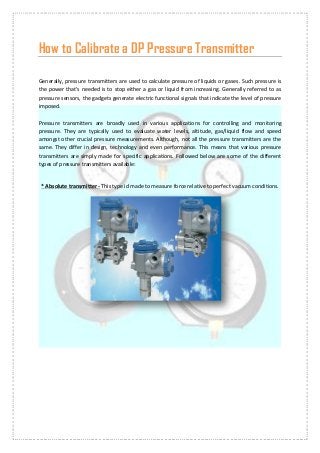
How to calibrate a dp pressure transmitter
- 1. How to Calibrate a DP Pressure Transmitter Generally, pressure transmitters are used to calculate pressure of liquids or gases. Such pressure is the power that's needed is to stop either a gas or liquid from increasing. Generally referred to as pressure sensors, the gadgets generate electric functional signals that indicate the level of pressure imposed. Pressure transmitters are broadly used in various applications for controlling and monitoring pressure. They are typically used to evaluate water levels, altitude, gas/liquid flow and speed amongst other crucial pressure measurements. Although, not all the pressure transmitters are the same. They differ in design, technology and even performance. This means that various pressure transmitters are simply made for specific applications. Followed below are some of the different types of pressure transmitters available: * Absolute transmitter - This type id made to measure force relative to perfect vacuum conditions.
- 2. * Gauge transmitter - This is one of the most common types of pressure transmitters available. A good example is the tire pressure gauge. A gauge pressure transmitter is used to check pressure relative to atmospheric pressure. * Vacuum transmitter - This type of pressure transmitter can be used to calculate pressure under atmospheric pressure and even absolute pressure. * Sealed transmitter - Although this type is just like gauge transmitter, it is basically suitable for calculating pressure relative to fixed pressure.
- 3. * Differential transmitter - This type is used to measure the difference between 2 pressures. Of all the above types, it's the differential pressure transmitter which differs considerably from the others. It should however be noted that the above mentioned are not the basically types of pressure transmitters available. There are other types whose difference usually is in the technology used. The DP pressure transmitter It is a kind of pressure transmitter which is made to measure pressure in two different environments. It is the transmitter of choice when it comes to measuring pressure drops in air filters, fluid levels and moreover changes in pressure when a liquid or gas flows. To provide correct pressure readings, calibration of a DP pressure transmitter is really crucial. The calibration process is however simple and straight forward. The initial step towards calibrating a DP pressure transmitter starts with filling 2 columns of the transmitter with a liquid. The two columns are then connected and generally have a level transmitter on the column. The calibration method involves calibrating the level transmitters, setting one column at zero level and the other at 100 %. Whereas setting one column at zero means setting the amount of the liquid to be even with that of the transmitter, setting the other column at 100 % is arbitrary because transmitter measures force change in relation to the other column. Besides the above mentioned procedure over, calibration of a DP pressure transmitter is not yet over. What follows is the multiplication of the fluid height by the liquid/gass gravity just before re- calibrating the transmitter to the new liquid column height. This yields the pressure in one specific column. It is only after this that the DP pressure transmitter process could be prepared to take pressure measurements.
